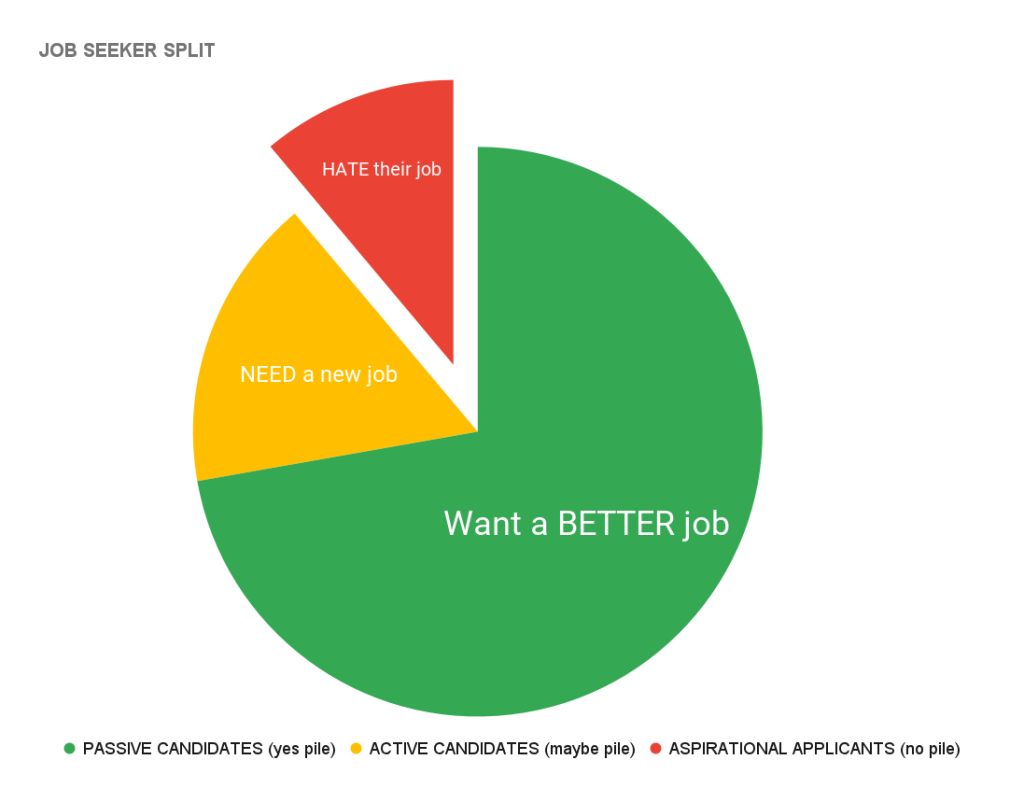
This is something 99% of my Talent Acquisition peers, hiring managers, founders and recruiting stakeholders we’ve worked with never consider – the type of applicant their job descriptions attract.
The talent pool is made up of only 3 job seeker types.
Aspirational job seekers who HATE their jobs.
Active job seekers who NEED to find new jobs.
And passive job seekers who WANT better jobs.
Aspirational and active job seekers make up only 30% of the talent pool, but the bulk of most job applications.
Aspirational Job Seekers (10%)
Are usually underqualified and end up in the bin.
Active Job Seekers (20%)
If you think of jobs as products and job seekers as buyers – then most active job seekers, at least 50% are reluctant buyers who have to buy; their circumstances are forcing them to make career decisions that are often deadline induced – so they have to apply for as many roles as possible.
The longer their job search goes on the more likely they are to take a job that probably isn’t a good fit.
They have to play the numbers game – register with multiple recruitment agencies and get job alerts from all the job boards – and crucially auto-apply for anything with their job title – most don’t have time to read job descriptions unless they get an interview request.
Most end up taking lateral transfer jobs – same role different company – then either quickly move on or perform like bored B players – because this hire satisfied an urgent need for the hiring company but offered very little in the way of growth or new challenges for the new joiner.
We’ve watched hiring managers spend weeks and even months chasing the strongest of these candidates through the interview process then lose them somewhere around offer stage due to demand for this small slice of the talent pool.
Passive Job Seekers (60%)
Passive job seekers on the other hand, who make up around 60% of the talent pool, are ironically, the most enthusiastic buyers when they see what they like, but apply for almost nothing; because they don’t have to make deadline induced career decisions.
They also receive job alerts – but as sophisticated buyers they wont make a purchase without first doing their research – as we all do before buying a high value item.
They skim every job description – and only apply for jobs that represent career moves – each job has about 8 seconds to grab their attention – and they have a lot to get through – so they spend most of their time reducing their jobs pile by looking for red flags (just like we do with applicants.)
Red flags include bogus mission statements, too many superlatives, hyperbole, poor tone, or the industry standard: Sisyphean lists of responsibilities, tasks and expected experience. duties. For them to make an informed decision it’s crucial they’re shown the scope and scale of a role. If that’s not visible they move onto the next job.
Passive job seekers are easy to find – but hard to engage – however, when we get them interested we have almost no competition; they’re not going on multiple interviews, and might not interview again for another nine months – they’re specifically interested in our role because it represents a genuine career move. They’re prepared to leave their job for our job – active job seekers were leaving their job anyway.
Which makes it a much bigger commitment, so when they join they have a bigger impact and they stay longer – their barriers to entry are high, but so are their barriers to exit.
